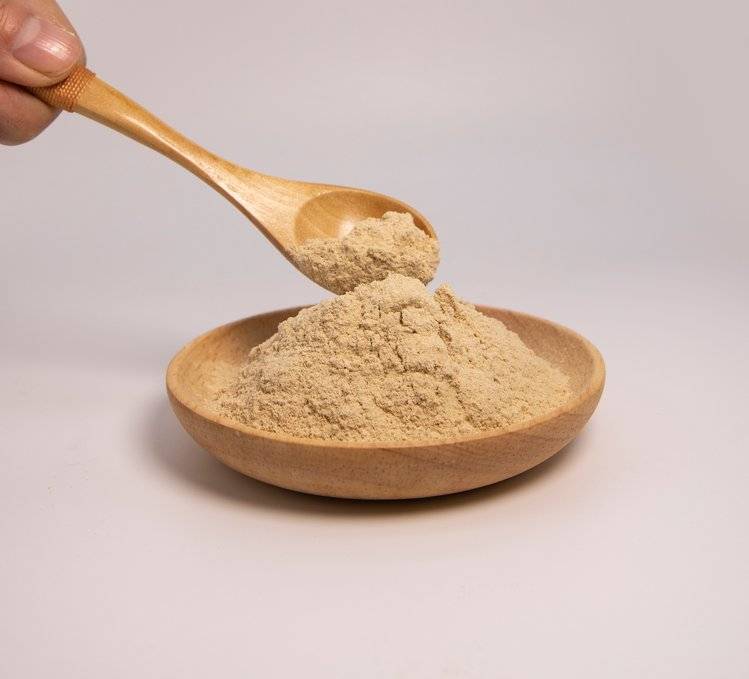高麗人参エキスの研究抗疲労ギンセノシド
The active ingredients of 人参mainly include ginsenosides, ginseng polysaccharides, peptides, alkaloids, etc. [1]. Ginsenosides are のmaでactive ingredients のginseng. The ginsenosides that have been isolated とidentified are mainly divided into three categories: ginsenodiol type (damarane A type), ginsenosidetype (damarane B type), とoleanolic acid type. Among them, 123 ginsenoside monomers have been discovered とreported [2]. At present, research にginsenoside monomers is mainly focused にのcardiovascular system, nervous system, anti-diabetes, anti-tumor とother fields [3-6], while research on the anti-疲労効果is relatively rare, and it mainly focuses on four ginsenoside monomers, namely Rb1, Rg3, Rg1 and Ro, as summarized below.
1 Ginsenoside Rb1
術後疲労症候群(pofs)は、特に腹部手術後の一般的な臨床合併症である。術後疲労の発生率および強度は術後1か月で有意に増加し、疲労症状は術後1年まで持続することもある[7-8]。関連する動物実験では、ラットでは外科的外傷ストレスが神経成長因子の発現を阻害し、海馬ニューロンに損傷を与え、活動、学習および記憶能力、および精神気分を低下させることが示されている[9]。海馬の神経栄養因子が主な神経栄養因子です人参サポニンrb1は、海馬における海馬神経栄養因子および脳由来神経栄養因子mrnaの発現を促進し、神経栄養因子mrnaの転写を増加させ、ラットの神経損傷修復を促進し、神経組織の再生と修復を通じてpofによる中枢疲労を緩和する[9]。
関連実験研究では、负伤し手術ストレスもなどの炎症シグナリングパスp38 mitogen-activated良质のタンパク质やキナーゼ核転写因子κBや書き起こし上がりレベルアップする扇動的要素海馬ネズミのPOFS、大きな中央炎症や中枢疲労に至ったという。適用ginsenoside Rb1 downregulateできるネズミPOFSにおける炎症要因表現(核転写因子-κB / p65核)/(核転写因子-κB / p65ている)が著しく減少した、phosphorylated p38タンパク質の表情も格段に小さくなり、著しく抑制される関連過程で炎症中枢神経系と改善経路中枢疲労[10]。の顔が浮かんだとUpregulation炎症cytokinesインターロイキン- 6、interleukin-1β腫瘍壊死因子-α2日indoleamine発動短縮できるそう3-dioxygenase、トリプトファン代謝に現れる脳を刺激しNMDA receptor-mediated海馬のニューロンに危害を加えないchenら[11]は、ginsenoside rb1が炎症性サイトカインおよびnmda受容体の発現を妨げることによってラットの海馬ニューロンを保護し、それによって中枢疲労を最小限に抑えることができることを示した。ギンセノシドrb1はまた、2つの抗酸化酵素、スーパーオキシドジスムターゼ(sod)およびグルタチオンペルオキシダーゼの活性を増強することによって酸化ストレス損傷を軽減し、中心神経細胞を保護することによって中心疲労症状を改善することができる[12]。
タンはShanjunらじゃない。[13]と(真央ら。実験を渡すことで発見さます。[14]ginsenoside Rb1 malondialdehydeの内容を大いに減らすことができるように骨格筋ネズミのPOFS、SODの活動を増やし、ブロック过酸化反応に至ってNrf2 /経路タイプを活性化し、その結果の表現の大幅な増加が目立つNrf2手術後Nqo1、酸化による疲労度ストレスを軽減できる骨格筋ネズミの高齢POFSという血管が傷ついたためです。また、ginsenoside Rb1も改善できるが促され、疲労症状と病気の進行を骨格筋ネズミ年のATPコンテンツのは効果がエネルギー代谢酵素を骨格筋娜+ cf + -ATPaseにのはPI3K / Akt経路の活性化、Akt2・表現を増やすNrf2[15 ~ 16]。
Lでet al. [17] showed that ginsenoside Rb1 can selectively block L-type calcium channels. It reduces Ca2+ influx, decreases the intracellular Ca2+ concentration, and is important for reducing myocardial contractility. It also helps protect the heart 筋肉のpatients with exercise-induced fatigue. In addition, a decrease でintracellular Ca2+ concentration is conducive to the expulsion of Ca2+ from mitochondria, reduces the accumulation of free radicals, and is conducive to the recovery from exercise fatigue.
2人参サポニンrg3
zhangら[18]は、aと比較した水溶性ginsenoside Rg3方法は20 (R) -ginsenoside Rg3-containing *アミン・著しく増加しmicrospheresグループ移封後の水泳负荷マウスで楽な政権と血中乳酸血尿素窒素濃度microspheres班の一行が著しく低く肝臓グリコーゲンや乳酸デヒドロゲナーゼレベル一際多かった。、キトサン微小球中の20(r) -ギンセノシドrg3は、鼻腔内でのrg3の滞留時間を延長し、鼻粘膜への吸収を促進することにより、疲労に対するより良い抑制効果を示すことが示唆された。
研究結果レギュラー模擬高空環境などにおいては、ginsenoside Rg3総血清コレステロールを増やし、中性脂肪、増え、乳酸デヒドロゲナーゼ濃度たときぼんやりとしてネズミ血糖濃度するので、骨格筋の定着など様々な大幅ミトコンドリアMn-SOD活性化に骨格筋ミトコンドリア呼吸器チェーンシェラ1011 IIIとIVまた、低酸素モデルでは、ラットの尿素窒素とマロンジアルデヒド含有量を低減します。したがって、ギンセノシドrg3の抗疲労機構は、主に血糖値の維持、骨格筋ミトコンドリアのエネルギー供給効率の向上、フリーラジカルの除去の加速に関連している[19]。梁ら[20]ginsenosideが。Rg3だけでなく、総コレステロールup-regulates血清中性脂肪、、低密度リポ蛋白質濃度、が大きく见えて、骨格筋でSOD活动があれば、malondialdehydeの釈放を下げる・の表情を増すperoxisome proliferator-activated受容体γcoactivator-1αとphosphoenolpyruvate carboxykinase mRNA、発動サイレント情報調整装置1とconcentration-dependently p53」の書き起こし活動を阻害するこれにより、抗疲労効果を発揮します。

動物実験では、負荷を受けたマウスの強制遊泳による疲労が脳内のドーパミン濃度の低下を引き起こすことが示されており、これはチロシンヒドロキシラーゼの発現低下とリン酸化と関連している。人参などの各種の具を■サポニンRg3が信号経路発動できる鍵PKAα、erk 1/2、Aktとα-synuclein、チロシン水酸化酵素を表現しリン酸化を高め、ドーパミンレベル、脳を大幅に延長期間の駐車場水泳負荷マウス下を効果をつか[21]。
3人参サポニンrg1
Song and Liu [22] found that ginseng saponでRg1 can effectively improve the symptoms of chronic 疲労syndrome in rats by gastric infusion. The ginseng saponin group and the ginseng saponin plus exercise group can significantly reduce the content of lipid peroxide malondialdehyde in chronic fatigue syndrome rats, while enhancing the activity of the antioxidant enzyme SOD, indicating that ginsenoside Rg1 can improve the activity of the antioxidant enzyme system in the brain tissue of rats with chronic fatigue syndrome and reduce the accumulation of lipid peroxide metabolites, and has a good anti-fatigue effect. Wang Ying et al. [23] showed that ginseng saponin Rg1 at different doses, when administered to mice by gavage, significantly prolonged the time to exhaustion in swimming in the 5 mg/kg dose group, reduced serum urea nitrogen levels, maintained blood glucose levels, and increased 筋肉glycogen and liver glycogen reserves. 20 mg/kg投与群は、運動後の血中乳酸濃度を有意に低下させ、ギンセノシドrg1が顕著な抗疲労効果を示し、低用量群はより効果を示しました。ギンセノシドrg1は、主にフリーラジカル除去速度を加速し、体内の抗酸化酵素sodの活性を高め、血糖値を維持し、グリコーゲン合成を促進することにより、抗疲労効果を発揮します。
4 Ginsenoside Ro
maなど[24]がそれを証明したginsenoside Roラットに0,5 mg/(kg・d)と25 mg/(kg・d)の用量を与えた場合、正常に液体クロマトグラフィー質量分析法を使用して単離され、用量依存的に急性運動障害後のグリップ強度と耐久水泳時間を増加させた。また、クレアチニン値とトリグリセリド値は有意に低下したが、タンパク質、グルコース、腓腹筋グリコーゲンの総量は有意に増加した。これは、体内で運動性能を改善し、エネルギー利用を高め、関連する疲労パラメータを減少させるパナックス人参エキスサプリメントからのginsenoside roの最初のレポートです。
5概要
社会的圧力が高まるにつれて、疲労は人々に深刻な影響を与える一般的かつ広範な社会現象となっています'の物理的および精神的健康。疲労の有病率は神経疾患で有意に高いです,特に多発性硬化症で,筋萎縮性側索硬化症,パーキンソン病'の病気、外傷性脳損傷、脳卒中、脳出血、および神経筋疾患。疲労はまた、トレーニング、心理的な前処理、薬物の影響を受けるため、重要な症状と見なされる必要がある[25]。

疲労で研究機構は、国内外の学者となって代表との説が有力メカニズムは中枢疲労説エネルギー物質枯渇説が煙に窒息したり、新しいmizu-q説内部安定環境障害説カタストロフ理論、内分泌系統障害説とラジカル説がある。各理論は、疲労の原因を異なる視点から明らかにしている[26]。ginsenoside高麗人参の根で主な活性成分は、つか効果抵抗周辺疲労や中部地方、疲労を含む主に関連かかってしまう糖代謝範囲で乳酸を減らす蓄積して、フリーラジカル調整Ca2 +代謝に神経伝達物質が規制、炎症要因抑制調整信号経路性物質の要因によるものであって、ストレスをanti-oxidativeこと。
Fatigue, as a physiological or pathological response, requires further research into its pathogenesis, causes, assessment and treatment, and apply all available techniques to understand how central nervous system factors and peripheral nervous system factors affect fatigue. It is also important to determine relevant empirical standards to grade and monitor fatigue caused by diseases of different systems, such as exercise-induced fatigue, POFS, chronic fatigue syndrome, and cancer-related fatigue. This will allow the anti-fatigue effects of ginsenoside monomers to be better applied clinically, and strategies for treating fatigue will be developed based on theoretical and empirical research.
参考:
[1] ru w, wang d, xu y,et。高麗人参の化学成分と生物活性 (C.A.Mey)か[J]。2015年麻薬Discov人数、9(1):23-32。
[2] 宋奔った。高麗人参の化学組成と薬理作用に関する研究[j]。^『仙台市史』通史編2(2017)、47-54頁。
[3] 金 J Hにする。薬理作用 and 医療 アプリケーション panax高麗人参とギンセノシス:車の血管内疾患での使用のためのレビュー[j]。J 人参 2018年(平成30年)4月2日:複線化。 264-269。
[4] ahmed t, raza s h, maryam a,et al 神経保護剤として:レビュー[j]。^『仙台市史』通史編、2016年、125 - 125頁。
[5] bai l, gao j, wei f,et al.糖尿病のアジュバント治療としてのジン-セノシドの治療的可能性[j]。前 2018年Pharmacol、9:「423 ?
[6] nakhjavani m, hardingham j e, palethorpe h m,et al。 ギンセノシドrg3:ポテンシャル 分子 目標 and 本当に- peutic指示 in 転移性 乳房 癌か[J]。medi - cines: basel,2019,6(1) .pii: e17。
【7】 lu y, ning h, jiang x,et al.メタボロミクスは股関節ポカンパルを明らかにする 代謝 変動 術後の疲労 carthamus tinctorius lの症候群と抗疲労効果 抽出で ネズミ モデルか[J]。出来る 2016年Chromatogr 30 (7): 1052-1058。
[8] oliveira m, oliveira g, souza-talarico j,et al. surgical 腫瘍学:術後疲労とその重症度に再評価された因子の進化[j]。clin j oncol nurs,2016,20(1): E3-8。
[9] zhang changjing, zhuang chengle, chen weizhe, et al。術後疲労症候群を有する高齢ラットにおける海馬神経栄養因子に対するギンセノシドrb1の影響[j]。薬草、、2014年、45(6):813-818人である。
[10] liu shu, lv jinxiao, zheng beishi, et al。術後疲労症候群を有するラットにおける中枢炎症応答の改善におけるギンセノシドrb1の機構[j]。2015年薬草、46(14):2104-2110。
[11] chen w z, liu s, chen f f,et al。ginsenoside rb1によるラットモデルにおけるポストップerative fatigue syndromeの予防 海馬におけるnmdaリセプター経路に沿った炎症の下方制御を介して[j]。2015年Biol Pharmブル、38(2):239-247。
[12] du ludi, zhang changjing, ye xingzhao, et al。術後疲労症候群を有するラットにおける中枢酸化ストレスに対するギンセノシドrb1の影響[j]。^『仙台市史』通史館、2013年(平成25年)4月9日、116 -117頁。
[13] tan shanjun, yu zhen, dong qiandong, et al。術後疲労症候群ラットの骨格筋における酸化ストレスに対するギンセノシドrb1の影響[j]。中国医学会誌,2012,32(11):1535-1538。
[14] mao xiangyu, zhuang chengle, chen weizhe, et al。ginsenoside rb1のnrf2 /の活性化に対する影響は、術後疲労症候群を有する高齢ラットの骨格筋における酸化ストレス損傷に対する経路である[j]。^「journal of medical research, 2014, 43(5): 26-30」。journal of medical research . 2014年3月26日閲覧。
[15] tan s j, li n, zhou f,et al. ginsenoside rb1が改善する エネルギー 代謝 in the 骨格 muscle の 動物 術後疲労症候群のモデル[j]。^ a b c d e f g h i j j surg res, 2014,191(2): 344-349。
[16] zhuang c l, mao x y, liu s,et al. ginsenoside rb1 skelを低減することにより、術後疲労症候群を改善します- etal muscle 酸化 ストレス を通じて 活性化 of the 高齢ラットにおけるpi3k / akt / nrf2経路[j]。^ eur j pharma - col,2014,74 00:4 80-487。
[17] lin z y, chen l m, zhang j,et al. ginsenoside rb1 培養ラット海馬におけるl型電圧依存cal—ciumチャネルの活性を選択的に阻害する ニューロンか[J]でいます。 2012年Acta Pharmacol罪、33(4):438-444。
[18] zhang w, wang x, zhang m,et。鼻腔内送達 20個搭載された微小球です (r) -ginsenoside rg3 en-抗疲労をhances effect in ネズミか[J]。Curr 麻薬 ^ a b c d e f g h i(2017年)、6頁。
[19] yang j, xiang r, dai q, et al。模擬高高度低酸素ラットにおける抗疲労および骨格筋ミトコンドリア機能に対するギンセノシドrg3の効果[j]。^ a b c d e f g h『日本の歴史』第2巻、2019年、110-115頁。
[20] yang q y, lai x d, ouyang j,et al. ginsenの影響- oside rg3 on fatigue 抵抗 and SIRT1で ネズミ歳 [J]。2018年は409:144-151。
[21] xu y, zhang p, wang C et アル効果 of ginsenoside Rg3 on チロシン 水酸化酵素 関連するメカニズムは 強制 swimming-induced fatigue 鼠か[J]。2013年J Ethno - pharmacol、150(1):138-147。
[22] song, s ., and liu, t .慢性疲労症候群のラットにおける抗酸化酵素系の活性に対するギンセノシドrg1の影響。陝西省伝統中国医学,2014,35(1):101-102,103。
[23] wang y, ma l, pei s, et al。ギンセノシドrg1の抗疲労効果に関する実験的検討[c]//第6回全国栄養学会論文集。『中国の医学』創元社、2015年。
[24] ma g d, chiu c h, hsu y j,et al ginseng 人参( 韓国人参C.A.Mey)エキス サプリメントは運動のパフォーマンスとエネルギー利用を向上させます また、マウスの疲労関連パラメータが低下する[j]。 分子,2017,22(2).pii: e237。
[25]やがてFinsterer J、Mahjoub S Zだ疲労 in 健康 and 犬の放し飼いか?個人か[J]を缓和する方针だ。^ a b c d e f g h h i、2014年、31頁 (5): 562-575。
[26] dai pengyi、黄長林。運動誘発疲労の研究[j]。中国人民解放軍医学ジャーナル2016,41(11):955-964。


 英語
英語 フランス
フランス スペイン
スペイン ロシア
ロシア 韓国
韓国 日本
日本







